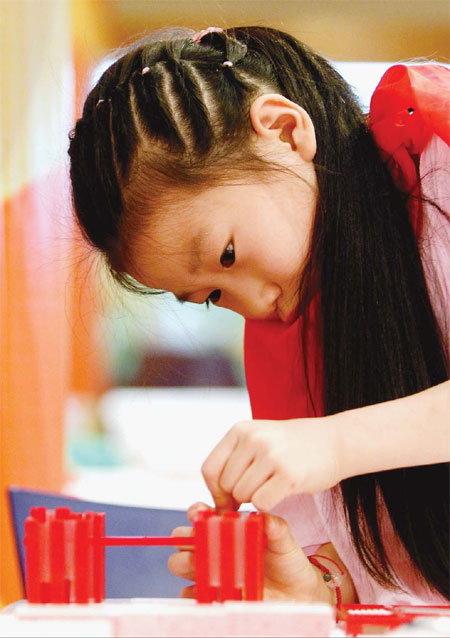The Expo in miniature
 |
| A young girl creates a model of the China Pavilion. |
The latest craze is building scale models of Expo pavilions, Wu Yiyao reports.
A picture may be worth 1,000 words, but some have found new ways to relive their Expo 2010 Shanghai experiences, test their creativity and discover new ways to reuse old materials - building models of Expo pavilions.
Once considered a hobby for children, constructing small model versions of pavilions has become a popular activity for both young people and adults.
Competitions for making miniature Expo pavilions have been increasingly popular in kindergartens and schools and on online forums. Building pavilions at home is also thought to be beneficial for developing artistic abilities, promoting awareness of environment protection and promoting teamwork.
The most popular pavilion to recreate has overwhelmingly been the UK Pavilion, nicknamed the Seed Cathedral, with its thousands of shining rods that sprout from the pavilion's facade.
"Basically you just need to pierce some toothpicks into a ball-shaped object. It could a piece of soap, a potato, a tomato, an apple, or dough," said Wang Xinyuan, a 7-year-old student who built a replica of the pavilion.
This year, the UK Pavilion won one of the United Kingdom's top international architectural awards, the Royal Institute of British Architects' Lubetkin Prize. With seeds sourced from the Germplasm Bank of Wild Species at the Kunming Institute of Botany, encased in each of the pavilion's 60,000 slender transparent rods jutting from its facade, the pavilion is a favorite for many visitors.
Like many others who have made model pavilions, Wang said that he enjoyed creating the pavilion and that it was the first time he had done that kind of project.
To mimic the special design of the rods, he used 300 toothpicks. "Any fewer and it looks too sparse and more makes it look like a hedgehog," he said.
"A hand-made model of a pavilion has a special meaning, more than a picture or souvenir could offer, because no money will buy something like this," he said.
The China Pavilion has also been a favorite among model makers.
"Many of my friends enjoy making mini-China Pavilions because we can build it with chopsticks," said Mao Junjun, a 27-year-old accountant. He joined an online group dedicated to making Expo replicas. Many of the group members exhibit their projects online.
But it is not easy to interlock the beams together.
"It requires a lot of calculation about the ratio of lengths of each block and the gap between each layer," Mao said. "I tried several times, but the draft did not look good at all."
Determined to have his own "Crown of the East", Mao spent several nights studying pictures of the pavilion taken from different angles. He even sketched a perspective drawing for his project.
He finally built up a chopstick version of China Pavilion, alongside his friends' versions of pencils, rulers and paper rolls.
Some builders have even made edible versions of pavilions so share with friends and family.
"I saw someone bake a rabbit-head-shaped cake and was inspired that I could make a cake version of the Macao Pavilion," said An Zhi. "I think I am going to keep it in the refrigerator rather than eat it."
Parents have also found that making miniature pavilions with their children has been a good way to spend time together. They said it was beneficial for their children to learn the skills that come with creating model pavilions.
"Kids may learn a lot about colors, shapes and basic principles of constructing things," said Ma Tingjun, a father of a 3-year-old girl. "It is a good opportunity for me to learn my child's preferences and tastes, too."
Ma said parents can learn a lot about their children from observing their decisions, from choosing what pavilion to make to selecting the materials to make the pavilion.
It also provides an opportunity to cultivate children's awareness in environmental protection.
When 4-year-old Zhou Shengjie was creating his replica of the France Pavilion, he decided to use old newspapers instead of unused paper. "That way I can save a new sheet of paper," he said.
Recyclable materials, including shoeboxes, tins, old newspapers and cards, are all useful and environmentally friendly resources when creating pavilion models.
"One way to ensure a better city and better life is to save everything we can," said Zhou. "My teacher told us that garbage is misplaced treasure. I hope I can give old things new life."
Teachers agree that building miniature pavilions helps students practice teamwork and many schools have organized Expo pavilion building competitions and exhibit them on campus. These competitions help students to learn skills, like teamwork, cooperation and organization, on their own.
Officials working at pavilions in the Expo Garden are glad to see miniature versions of their pavilions as well.
"I'm quite surprised that there are actually people making model pavilions," said Julia Mok-Russo, deputy commissioner-general of the Germany Pavilion. "It is quite meaningful that they enjoy building the models, especially since they're not doing it for commercial purposes."
Mok-Russo said she hoped she could see some of the models and take some pictures.
As most of pavilions in the Expo Garden will be dismantled after the Expo, making a miniature model is also one way to keep the memories from the Expo alive, said Yang Yue, a press officer from the Spain Pavilion.
"We are glad to see visitors making miniatures of our pavilion and would like to circulate their work with the other visitors to promote the pavilion," Yang said.
 0
0 







Go to Forum >>0 Comments